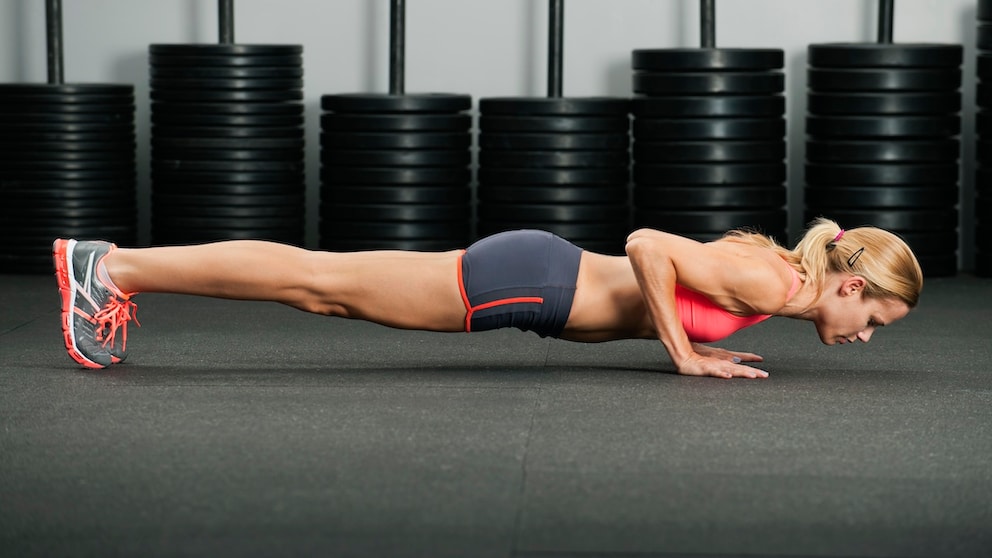February 8, 2025, 3:51 pm | Read time: 3 minutes
Everyone knows them: push-ups. This bodyweight exercise not only trains the chest muscles and triceps but also improves body tension. But be careful! There are a few things you can do wrong with push-ups.
Push-ups are particularly effective and can be done anywhere without equipment. However, if you want to avoid injury and see results, you should perform the exercise correctly with your own weight. Read on to find out what to look out for when doing push-ups and what mistakes you should avoid.
Overview
- Which Muscles Are Trained During Push-Ups?
- 1st Mistake: Sagging Back
- 2nd Mistake: Buttocks Too Far in the Air
- 3rd Mistake: The Cervical Spine Is Overstretched or Sagging
- 4th Mistake: The Elbows are Too Far Away from the Body
- 5th Mistake: Hands Positioned Too Far to the Outside
- 6th Mistake: The Full Range of Motion Remains Unused
Which Muscles Are Trained During Push-Ups?
Push-ups primarily target the chest muscles. These are supported by the shoulder muscles and the triceps. However, because you have to tense your entire body to perform the exercise correctly, you also activate other muscles in the buttocks, abdomen, and thighs, among others. The support position requires tension throughout the entire body.
1st Mistake: Sagging Back
Sufficient body tension is the be-all and end-all when doing push-ups. This is because if your back sags, this not only reduces the success of your training but also risks overloading the lumbar spine and even causing pain and injury due to the formation of a hollow back. So, if you find it difficult to tense your torso during the exercise, you can do push-ups on your knees first.
2nd Mistake: Buttocks Too Far in the Air
It’s also crucial to keep your buttocks in the correct position. This means: Don’t stretch too far upwards! By tensing the gluteal and core muscles, the upper and lower body should form a line. This prevents overloading.
3rd Mistake: The Cervical Spine Is Overstretched or Sagging
The same applies to the posture of the head: neck pain can result from incorrect head alignment. Your gaze should, therefore, be directed towards the floor during push-ups as a kind of extension of the spine. But be careful not to let it sag downwards, as this can also contribute to neck pain!
4th Mistake: The Elbows are Too Far Away from the Body
If you don’t yet have enough strength in your chest and shoulders to do several push-ups in a row, you tend to move your elbows outwards. This modification simplifies the exercise. The shoulder muscles do more work and take the strain off the chest. Therefore, if you want to train your chest muscles optimally, position your elbows at a 45-degree angle between your ribs and shoulders.
5th Mistake: Hands Positioned Too Far to the Outside
If you position your hands incorrectly, this can increase the strain on your shoulders and, above all, your wrists. You can avoid this by placing your hands at shoulder height next to your body. In addition, the elbows should always point towards the upper body.

Multifunctional exercise How to perform plank rows correctly

Correct execution Dumbbell Flyes – ideal exercise for chest, shoulders and triceps

Trainer explains Glute bridge vs. hip thrust – which exercise is more effective for the glutes?
6th Mistake: The Full Range of Motion Remains Unused
Another typical mistake with push-ups is that they are often only performed “half-heartedly.” Sometimes, they are only performed in the lower or upper half of the exercise. However, for optimal stimulation of the chest muscles, the full range of motion must be mastered. In the upper position, the arms are stretched – but the elbows are not overstretched – and in the lower position, the chest is almost resting on the floor. This ensures that the muscle remains constantly under tension.

